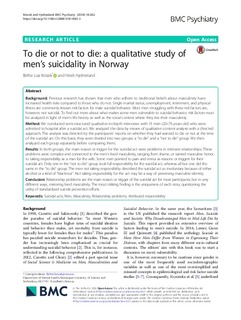| dc.description.abstract | Background
Previous research has shown that men who adhere to traditional beliefs about masculinity have increased health risks compared to those who do not. Single marital status, unemployment, retirement, and physical illness are commonly known risk factors for male suicidal behavior. Most men struggling with these risk factors are, however, not suicidal. To find out more about what makes some men vulnerable to suicidal behavior, risk factors must be analyzed in light of men’s life history as well as the social context where they live their masculinity.
Method
We conducted semi-structured qualitative in-depth interviews with 15 men (20–76 years old) who were admitted to hospital after a suicidal act. We analyzed the data by means of qualitative content analysis with a directed approach. The analysis was directed by the participants’ reports on whether they had wanted to die or not at the time of the suicidal act. On this basis, they were divided into two groups: a “to die” and a “not to die” group. We then analyzed each group separately before comparing them.
Results
In both groups, the main reason or trigger for the suicidal act were problems in intimate relationships. These problems were complex and connected to the men’s lived masculinity, ranging from shame, or tainted masculine honor, to taking responsibility as a man for the wife. Some men pointed to pain and ennui as reasons or triggers for their suicidal act. Only one in the “not to die” group took full responsibility for the suicidal act, whereas all but one did the same in the “to die” group. The men not taking responsibility described the suicidal act as involuntary because of either alcohol or a kind of “black-out”. Not taking responsibility for the act may be a way of preserving masculine identity.
Conclusion
Relationship problems are the main reason or trigger of the suicidal act for most participants, but in very different ways, mirroring lived masculinity. The most striking finding is the uniqueness of each story, questioning the utility of standardized suicide prevention efforts. | nb_NO |

